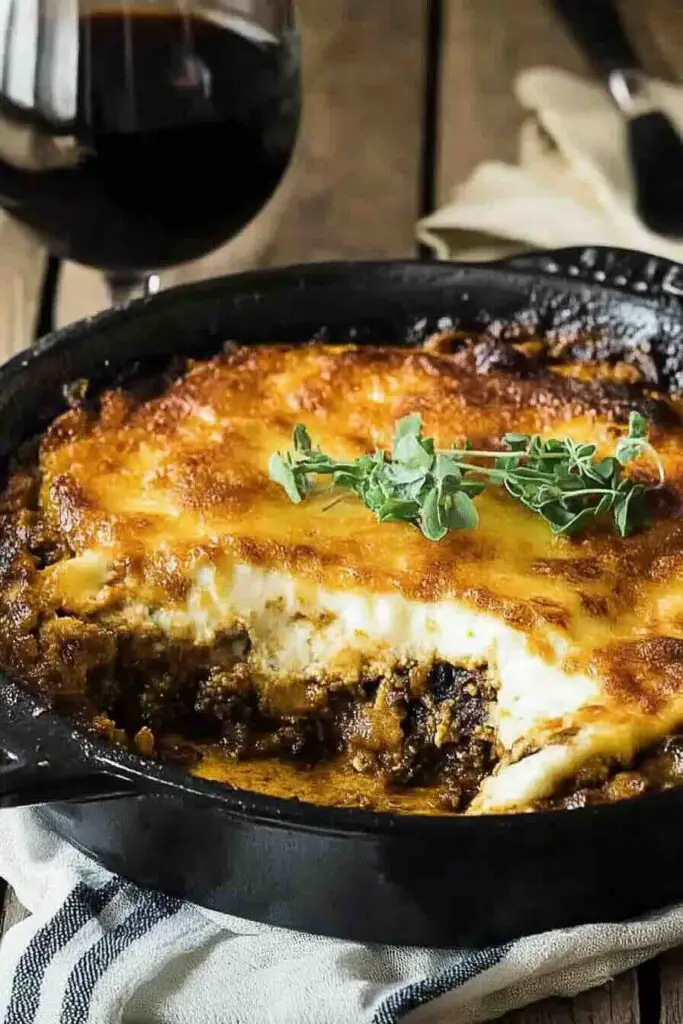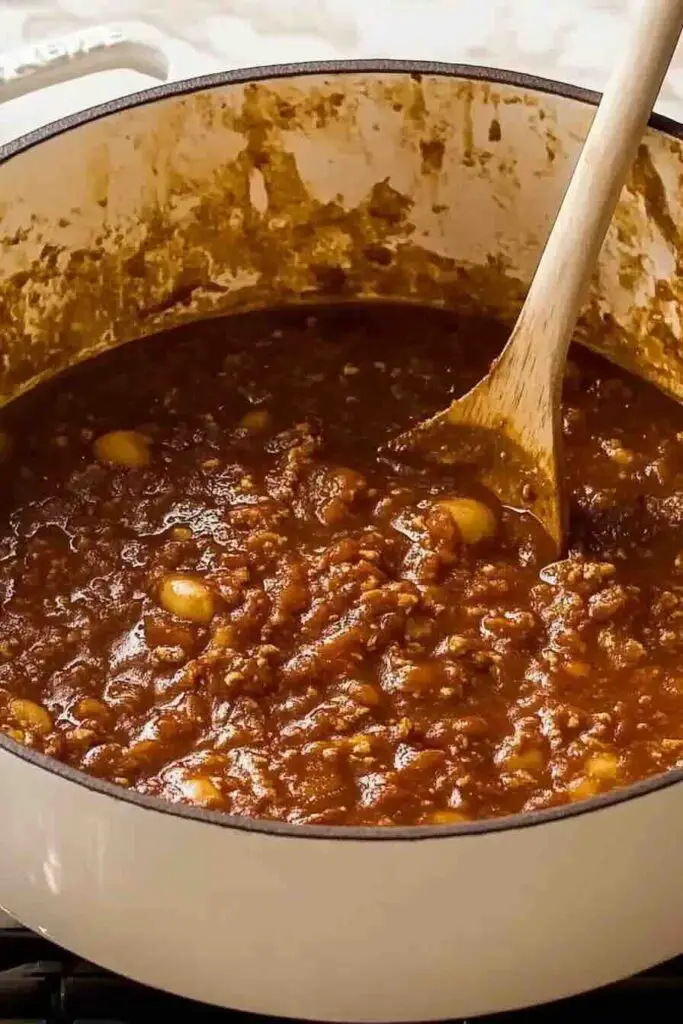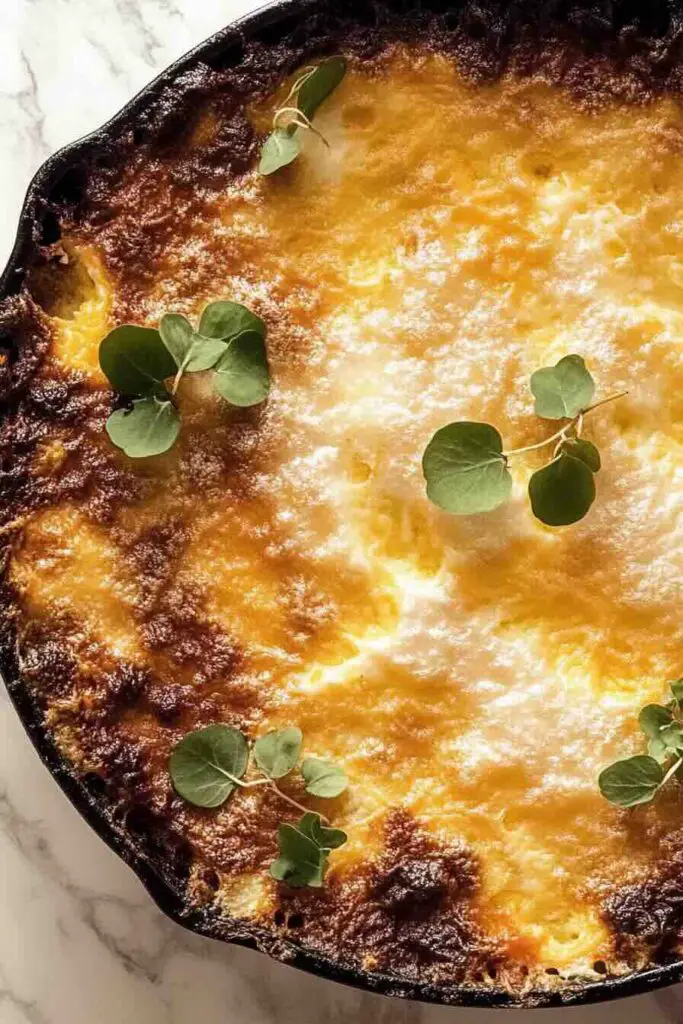Moussaka is the ultimate Greek comfort food, a dish that brings layers of love to your plate. Think tender roasted eggplant, a rich and spiced meat sauce, and a creamy béchamel topping that’s baked to golden perfection. Oh wow, is it good! Often compared to lasagna, moussaka is its own unique creation, bursting with the vibrant flavors of the Mediterranean. Whether you’re hosting a family dinner or just craving something special, this dish is worth every step—promise!
Not sure where to begin? Don’t worry! I’ll guide you through the process step by step, making sure you feel like a kitchen rockstar by the end. So, let’s dive into this savory Greek masterpiece and bring a little Mediterranean magic to your home.

Reasons You’ll Love This Recipe
An Authentic Greek Classic
This recipe is inspired by traditional Greek cookbooks and culinary wisdom passed down through generations. It’s the real deal!
Incredible Flavor Depth
The warm spices like cinnamon and oregano in the meat sauce create a flavor profile that’s nothing short of DA BOMB!!!
Creamy, Comforting Béchamel Sauce
The béchamel layer is pure velvet—it’s rich, indulgent, and makes moussaka stand out from its Italian cousin, lasagna.
A Great Make-Ahead Dish
Moussaka isn’t just tasty—it’s practical! You can prep it in advance, and it freezes like a dream.
Easier Than You Think!
With my clear instructions, you’ll see this dish isn’t as intimidating as it looks. Just follow along, and you’ll nail it!
What Makes a Good Moussaka?
Making moussaka can feel like an art form, but the secret lies in nailing the basics. Here’s what makes a standout dish:
Balanced Layers
Each layer should shine without overpowering the others. A harmonious stack is key!
Perfectly Cooked Eggplant
Roasting instead of frying keeps the eggplant tender without becoming a greasy mess.
Rich, Well-Seasoned Meat Sauce
A slow-simmered sauce with ground beef or lamb is essential for that deep, hearty flavor.
A Luxurious Béchamel Topping
The béchamel should be thick, smooth, and creamy enough to hold its shape.
The Cultural Significance of Moussaka
Moussaka isn’t just a dish; it’s a slice of Greek tradition. Known for its rich, comforting layers, it’s been a centerpiece of Mediterranean cuisine for centuries.
A Staple of Greek Cuisine
For many families, moussaka is synonymous with celebrations and comfort. It’s a dish that tells stories of home, heritage, and happiness.
Mediterranean Influence
While its origins are rooted in the Middle East, Greek moussaka stands out with its signature béchamel layer, a nod to French culinary techniques.
A Celebratory Dish
You’ll often find moussaka served during festive occasions or Sunday family dinners in Greece.
History of Moussaka
The journey of moussaka is as layered as the dish itself!
Ottoman and Middle Eastern Roots
Moussaka’s history begins in the Middle East, where layered eggplant dishes were common.
French Influence
In the early 20th century, a Greek chef named Tselementes added béchamel sauce, elevating it to the creamy masterpiece we know today.
Greek Evolution
Over time, moussaka became a national treasure, reflecting the country’s rich culinary tapestry.
Ingredients
Here’s everything you’ll need to create your own moussaka:
Eggplant Layer
- Eggplants (3 large)
- Salt
- Olive oil
Meat Filling
- Ground beef or lamb (500g)
- Onion (1 large, diced)
- Garlic (3 cloves, minced)
- Crushed tomatoes (400g can)
- Tomato paste (2 tbsp)
- Red wine (optional, ½ cup)
- Beef broth (½ cup)
- Bay leaves (2)
- Oregano (1 tsp)
- Cinnamon (½ tsp)
- Sugar (1 tsp)
- Salt and pepper to taste
Béchamel Sauce
- Butter (50g)
- Flour (50g)
- Milk (500ml)
- Nutmeg (a pinch)
- Parmesan or kefalotiri cheese (¼ cup, grated)
- Egg yolk (1 large)
Topping
- Panko breadcrumbs (2 tbsp)
Equipment Needed
Essential Tools
- Colander – For salting eggplant to remove excess moisture.
- Baking trays – To roast the eggplant.
- Large skillet – For sautéing the meat sauce.
- Whisk – For smooth béchamel.
- Baking dish – To assemble and bake.
Step-by-Step Instructions

1. Prepare the Eggplant
Slice the eggplants into ½-inch rounds, sprinkle with salt, and let them sweat for 30 minutes. This removes bitterness and moisture. Rinse, pat dry, brush with olive oil, and roast at 200°C (400°F) until soft.
2. Cook the Meat Sauce
Sauté onions and garlic in olive oil until fragrant. Add the ground meat, breaking it up as it browns. Stir in the tomatoes, tomato paste, red wine, broth, bay leaves, and spices. Let it simmer for 20 minutes to develop those bold flavors.
3. Make the Béchamel Sauce
Melt butter in a saucepan, whisk in flour, and cook until it forms a roux. Gradually add milk, whisking constantly to avoid lumps. Once thickened, season with nutmeg and stir in cheese. Off the heat, whisk in the egg yolk for extra richness.
4. Assemble
In a greased baking dish, layer roasted eggplant, meat sauce, another layer of eggplant, and then pour over the béchamel. Sprinkle with breadcrumbs for a crispy top.
5. Bake
Bake at 180°C (350°F) for 30–40 minutes or until the top is golden brown and bubbling. Let it rest for 10 minutes before slicing.
How to Tell When Moussaka is Done
Cooking moussaka to perfection isn’t hard if you know what to look for. The dish should have a beautiful golden-brown crust on top, which is the first sign that it’s ready to be devoured. The breadcrumbs and cheese in the béchamel topping should toast lightly, creating an irresistible, slightly crisp texture. If the top is pale, give it a few more minutes under the heat.
Another way to check is to gently shake the baking dish. The béchamel layer should feel set and stable, not wobbly or runny. A liquidy top indicates it needs more time to cook and firm up. You can also use the tried-and-true knife test: insert a knife into the center of the moussaka, and it should come out clean, with no creamy residue sticking to it.
Finally, temperature matters! When moussaka is fully cooked, a knife or skewer inserted into the middle should feel hot to the touch when removed. This ensures that all the layers, especially the meat sauce, have reached the right internal temperature for safe and delicious eating. Remember, letting the dish rest for about 10–15 minutes after baking helps the layers settle, making it easier to slice and serve.
Variations & Toppings
Moussaka is a dish that can adapt beautifully to different dietary needs, ingredient preferences, and creative spins. While the traditional recipe is undoubtedly delicious, these variations offer exciting ways to keep it fresh and interesting.
Vegetarian Moussaka
For a plant-based version, swap the meat filling with hearty ingredients like lentils, mushrooms, or even chickpeas. These substitutes soak up the spices and flavors, creating a satisfying dish that doesn’t feel like it’s missing anything. You can even add zucchini or roasted red peppers for extra layers of texture and taste.
Potato Moussaka
If you’re not a fan of eggplant, or simply want to try something new, replace the eggplant layers with thinly sliced potatoes. Sweet potatoes work too, adding a slightly sweet twist that pairs beautifully with the savory meat sauce and béchamel.
Mixed Vegetable Moussaka
Why stop at eggplant? Add roasted zucchini, bell peppers, or even carrots to the layers. This version is colorful, packed with nutrients, and perfect for veggie lovers.
Dairy-Free Béchamel
A creamy béchamel is essential for moussaka, but you can make it dairy-free by using plant-based milk like almond, oat, or soy. Olive oil or vegan butter can replace the traditional butter, and nutritional yeast adds a cheesy flavor without the dairy.
Toppings
Finish your moussaka with a sprinkle of fresh parsley, dill, or oregano for a touch of freshness. If you’re a cheese lover, add a generous layer of grated parmesan or kefalotiri before baking for an extra crispy, cheesy crust.
Pro Tips & Tricks
Mastering moussaka comes down to a few clever techniques and thoughtful details. These tips will ensure your dish is a showstopper every single time.
Avoid a Watery Moussaka
Eggplant has a high water content, which can make your moussaka soggy if not handled properly. The key is salting the slices and letting them sweat for about 30 minutes. This draws out excess moisture and bitterness. After sweating, rinse them thoroughly and pat them dry before roasting.
Perfect Your Béchamel
The béchamel sauce is the crown jewel of moussaka, so getting it right is crucial. Use a whisk to stir constantly as you add the milk to avoid lumps. If the sauce feels too thick, you can thin it out with a splash of warm milk. For extra creaminess, whisk in a little grated cheese just before pouring it over the layers.
Enhance Meat Sauce Flavor
A rich and flavorful meat sauce is the backbone of moussaka. Allow it to simmer for a good 20–30 minutes to develop deep, robust flavors. Adding a splash of red wine elevates the sauce, while a pinch of sugar balances the acidity of the tomatoes.
Assembling Like a Pro
Layering is key! Start with a base layer of eggplant to support the meat sauce, then alternate until the dish is filled. Always finish with a generous layer of béchamel to seal in all the flavors.
Storage & Health Tips
Moussaka is one of those dishes that tastes even better the next day. It’s a perfect make-ahead meal, whether you’re meal-prepping for the week or freezing leftovers for a busy day.
Storing Leftovers
Once the moussaka has cooled to room temperature, transfer any leftovers to an airtight container. Store it in the refrigerator for up to four days. For the best flavor, reheat individual portions in the oven rather than the microwave, as this helps maintain the dish’s texture and prevents sogginess.
Freezing Instructions
Moussaka freezes wonderfully, making it a fantastic option for batch cooking. Let the dish cool completely, then wrap it tightly in plastic wrap and foil. Store it in the freezer for up to three months. When you’re ready to enjoy it, thaw it overnight in the fridge and reheat in the oven at 180°C (350°F) until heated through.
Reheating Tips
To bring leftovers back to life, cover the dish with foil and bake it in the oven to avoid drying out the top. For an extra crispy topping, remove the foil during the last few minutes of reheating.
Health Insights
Moussaka is surprisingly balanced, especially if you roast the eggplant instead of frying. It’s high in protein, thanks to the meat and béchamel sauce, and the eggplant provides a good dose of fiber. For a lighter version, you can use lean ground meat and substitute half of the béchamel with a yogurt-based topping.

FAQs
How is moussaka different from lasagna?
Moussaka and lasagna might look similar, but they’re worlds apart in flavor and ingredients. Moussaka features layers of eggplant instead of pasta sheets and is topped with a creamy béchamel instead of ricotta or mozzarella. The spices, like cinnamon and oregano, give it a distinctly Mediterranean flair that sets it apart from the Italian classic.
Can I make moussaka ahead of time?
Absolutely! Moussaka is a fantastic make-ahead dish. You can assemble it a day in advance and keep it in the fridge, ready to bake when needed. Alternatively, you can bake it, cool it, and reheat individual servings as required.
What does moussaka literally mean?
The word “moussaka” has Arabic origins, derived from “musaqqa’a,” which means “chilled” or “moistened.” While today’s Greek moussaka is served warm, its Middle Eastern roots trace back to a similar cold dish.
What cheese is best for moussaka?
Traditionally, moussaka is made with kefalotiri cheese, a hard, salty Greek cheese. However, parmesan or pecorino are great substitutes if kefalotiri isn’t available.
Can I use zucchini instead of eggplant?
Definitely! Zucchini is a popular alternative to eggplant in moussaka. It has a mild flavor that pairs beautifully with the meat sauce and béchamel. Just like with eggplant, slice and roast it to remove excess moisture before layering.
Before You Go…
If you loved this moussaka recipe, you’ll adore Chicken Marsala, or maybe try your hand at Chicken Francese, And hey, don’t forget to subscribe for more mouthwatering Mediterranean recipes. Happy cooking! 😊
Print
Moussaka Recipe
- Prep Time: 40 minutes
- Cook Time: 1 hour 10 minutes
- Total Time: 1 hour 50 minutes
- Yield: 8 servings 1x
Description
This authentic moussaka recipe brings the taste of Greece to your table! With layers of roasted eggplant, spiced meat sauce, and creamy béchamel, it’s a comforting casserole perfect for family dinners or special occasions. Packed with Mediterranean flavors, this dish is sure to become a favorite.
Ingredients
Eggplant Layer:
- 3 large eggplants (sliced into 1/4-inch rounds)
- 2 tsp salt (for sweating the eggplant)
- 3 tbsp olive oil
Meat Sauce:
- 2 tbsp olive oil
- 1 large onion (finely chopped)
- 3 garlic cloves (minced)
- 500g (1 lb) ground beef or lamb
- 1/2 cup red wine (optional)
- 1 can (400g) crushed tomatoes
- 2 tbsp tomato paste
- 1/2 cup beef broth
- 1 tsp dried oregano
- 1/2 tsp cinnamon
- 1 bay leaf
- 1 tsp sugar
- Salt and pepper (to taste)
Béchamel Sauce:
- 4 tbsp butter
- 4 tbsp all-purpose flour
- 2 1/2 cups whole milk (warmed)
- 1/2 tsp nutmeg
- 1/2 cup grated parmesan cheese (or kefalotiri)
- 1 egg + 1 egg yolk (beaten)
Topping:
- 1/4 cup panko breadcrumbs
- 2 tbsp grated parmesan cheese
Instructions
- Prepare the Eggplant:
- Slice eggplants, sprinkle with salt, and let them sweat for 30 minutes. Rinse and pat dry.
- Brush slices with olive oil and roast at 200°C (400°F) for 20 minutes, flipping halfway.
- Cook the Meat Sauce:
- Heat olive oil in a skillet. Sauté onion and garlic until softened.
- Add ground meat and cook until browned.
- Stir in wine (if using) and simmer until reduced.
- Add tomatoes, tomato paste, beef broth, oregano, cinnamon, bay leaf, sugar, salt, and pepper. Simmer for 20–30 minutes.
- Make the Béchamel Sauce:
- Melt butter in a saucepan. Whisk in flour and cook for 2 minutes.
- Gradually add warm milk, whisking continuously, until thickened.
- Remove from heat, stir in nutmeg and parmesan. Cool slightly, then whisk in eggs.
- Assemble the Moussaka:
- In a greased baking dish, layer half the eggplant slices, followed by the meat sauce, and then the remaining eggplant.
- Pour béchamel sauce over the top, spreading evenly. Sprinkle breadcrumbs and parmesan on top.
- Bake:
- Preheat oven to 180°C (350°F). Bake the moussaka for 45–50 minutes, or until the top is golden brown.
- Let it rest for 10–15 minutes before serving.
Notes
- For a vegetarian version, replace the meat with lentils or mushrooms.
- Moussaka freezes well! Cool completely, wrap tightly, and freeze for up to 3 months.
- For extra flavor, let the meat sauce simmer longer.
Nutrition
- Calories: 434
- Sugar: 10g
- Sodium: 670mg
- Fat: 25g
- Carbohydrates: 28g
- Fiber: 6g
- Protein: 23g
